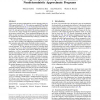Free Online Productivity Tools
i2Speak
i2Symbol
i2OCR
iTex2Img
iWeb2Print
iWeb2Shot
i2Type
iPdf2Split
iPdf2Merge
i2Bopomofo
i2Arabic
i2Style
i2Image
i2PDF
iLatex2Rtf
Sci2ools
109
click to vote
PLDI
2012
ACM
2012
ACM
Proving acceptability properties of relaxed nondeterministic approximate programs
Approximate program transformations such as skipping tasks [29, 30], loop perforation [21, 22, 35], reduction sampling [38], multiple selectable implementations [3, 4, 16, 38], dynamic knobs [16], synchronization elimination [20, 32], approximate function memoization [11], and approximate data types [34] produce programs that can execute at a variety of points in an underlying performance versus accuracy tradeoff space. These transformed programs have the ability to trade accuracy of their results for increased performance by dynamically and nondeterministically modifying variables that control their execution. We call such transformed programs relaxed programs because they have been extended with additional nondeterminism to relax their semantics and enable greater flexibility in their execution. We present language constructs for developing and specifying relaxed programs. We also present proof rules for reasoning about acceptability properties [28], which the program must satisfy ...
Dynamic Semantics | PLDI 2012 | Programming Languages | Subject Descriptor | Target Programming Language |
| Added | 27 Sep 2012 |
| Updated | 27 Sep 2012 |
| Type | Journal |
| Year | 2012 |
| Where | PLDI |
| Authors | Michael Carbin, Deokhwan Kim, Sasa Misailovic, Martin C. Rinard |
Comments (0)

